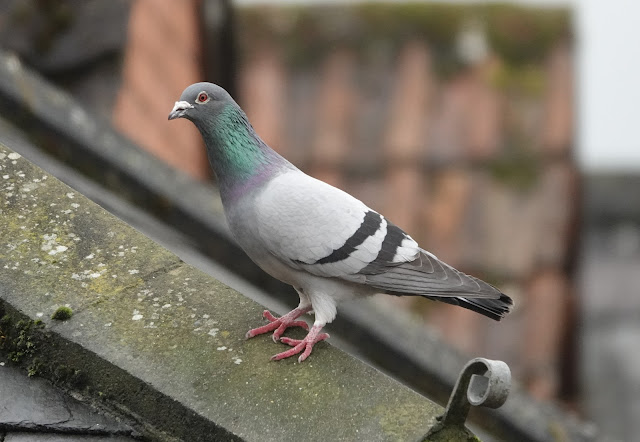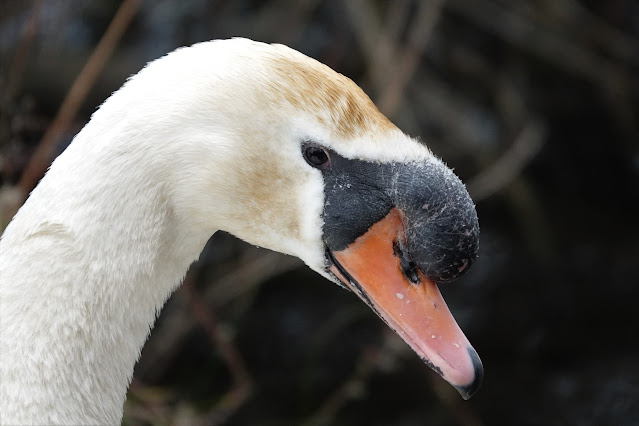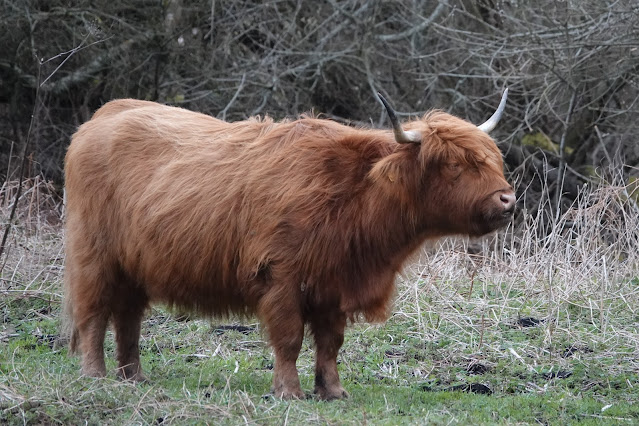I opened the curtains at 6.30 and was greeted by some
splendid roof top Feral Pigeons going about their business and even took some
pictures of the Ferns on the tiles that included a fine Polypody sp and the
scarce Rustyback. When we came out of the hotel we
suddenly realised that the majestic Wells Cathedral was literally across the
road and after a quick snap (and a Raven overhead) we set off for the Avalon
Marshes.
 |
| Feral Pigeon - so smart but ignored |
 |
| Rustyback - Ceterach officinarum |
 |
| Polypody sp |
 |
| Wells Cathedral |
A Sparrowhawk was added on the way and we soon turned off towards
Sharpham and wiggled our way through the lane of active peat works and packing
plants (surely their days are numbered?) and parked up by the pit I had been
sent to. A immature female Lesser Scaup
had been around for weeks (in fact arriving just two days after I was last down
here) and she had been on this particular pit for some time now. A singing Chiffchaff greeted us as we got out
of the bus and Pochard and Great Crested Grebe were new for the trip. I scanned the small numbers of Tufted Duck
and Pochard present and found her after about ten minutes. Thankfully she was close enough that I could
talk the crew through the features of this difficult age and plumage. In fact it was only the second one I had
seen, the rest being males of one age or another. It was a new bird for three of the
group. Great White Egrets drifted around
and the fields were full of Mute Swans along with a few Canada and Greylag
Geese.

 |
| 1w f Lesser Scaup |
 |
| 1w f Lesser Scaup |
Pleased with the early success we continued the circuit and found our
selves at Ham Wall. The two Glossy Ibis had been generally very hit and miss so
we were very happy to find them almost immediately on the main flood. It was good job that I checked through a gap
when I had a chance as they were soon spooked by a Marsh Harrier and we never
saw them again! With a little bit of sun
on them they were even actually living up to their name with green wings and a
rich vinous hue to their bodies. There
were more Great Whites and Little Egrets and the Cormorants were on nests in
the stunted dead trees.
 |
| Common Buzzard |
.jpg) |
| Glossy Ibises - Andy Buck |
Cetti’s Warblers were very vocal and there were a few more
Chiffchaffs and we all had good views of several foraging birds with their
pumping tails. A couple of half hearted
Reed Buntings sang and a male Stonechat hunted from the channel side vegetation
where a full breeding plumage Great White Egret stalked the margins.
.jpg) |
Stonechat - Andy Buck
|
.jpg) |
| Chiffchaff - a very pale billed bird - Andy Buck |
.jpg) |
| Chiffchaff - Andy Buck |
 |
| Great White Egret |
We veered off and down towards the Avalon tower hide negotiating
our way past the posturing Robins guarding the bridge! It was a bit muddy in
places with a Vicar of Dibley-esque puddle to be avoided on the way. Water Rails were vocal and Great Crested and
Little Grebes could be heard.
 |
| Robins |
The Barn Owls had obviously been using the hide but we found
clean seats and settled in for a Bittern watch. There were Marsh Harriers,
Egrets, wildfowl and invisible Water Rails but no Bitterns till a minute before
we were going to leave when two lads from Norfolk walked in, sat down and said
‘ Bittern climbing the reeds…’ It lingered just long enough to raise the bins
before a very nice flap across to the next stand of reeds. The steely blue cere of this male was visible
even in flight!
 |
| Marsh Harrier |
.jpg) |
| Bittern - Andy Buck - he was quick off the mark! |
.jpg) |
| Bittern - Andy Buck |
.jpg) |
| Bittern - Andy Buck |
We thanked the Norfolk Wildlife Trust lads and headed back
for lunch in the car park before part two took us across the road onto the
Shapwick Heath side. We walked as far as
Noah Lake which I had not been to before hearing the booming of Bitterns both
sides of the path on the way. Noah’s was
teaming with Wigeon along with a few other dabblers but it was the clouds of
Sand Martins skimming the service that we had come to find and were not disappointed. I have seen a handful of March birds before
but nothing on this scale. Tiny flies
were evident and they were zooming close to the water after morsels. It was wonderful to just close your eyes and
hear the buzzing of this epic traveller as they revelled in the available food.
 |
| Blackthorn |
 |
| Andy and the Egret |
 |
| Sand Martins hawking amongst the duck |
I scanned for the Ring-necked Duck but there were only a few
Tufted Ducks and Lesser Black-backs predominated over Herring and Black-headed
Gulls. I could see a couple of low Heron
nests in a stunted tree and several Great White platforms stacked up high in
the Phragmites.
We crossed over to the adjacent Seventy Acres Hide with the reverberating sound of a close Bittern sucking in air before letting it out in four long
ooom-baaaahs. We sat in the hide and saw
nothing; came back out and he did it again!
Lords and Ladies were pushing through in big clumps and I
found some scarlet Elf Cups on rotting logs; my first for some years. Bullfinches called in the Alder Carr and it
was just crying out for a Lesser Spotted Woodpecker.
 |
| Elf Cup |
 |
| Lords and Ladies |
 |
| Cotoptriche marginea |
 |
| Periwinkle |
.jpg) |
| Dave and Margaret - the former in full ornithological battle mode |
We opted to retrace our steps to Ham Wall and then drive
around to the other end of Shapwick. It rained all the way but thankfully let
up once again when we stopped by the bridge.
The trail took us through the trees and we could once again here
Bitterns along with ‘kipping’ Water Rails and clucking Moorhens. Chiffchaffs were singing well and a huge cob
Mute Swan sat defiantly by the path. If
you will pardon the phrase, he had the biggest knob I have ever seen on one.
.jpg) |
| Mute Swan - Andy Buck |
 |
| Mute Swan |
The North Kent posse were coming the other way but had not
seen the Ring-necked Duck on Decoy Lake but we pressed on and spent a wonderful
time out of the light rain watching the pit.
I checked all the Tufties but there was no RND and it would appear that
there are large bits of invisible water between here and Noah Lake beyond. Great Crested Grebes were cruising in pairs
but were not displaying and seven Great White Egret nests could be seen in the
reeds with adults moving in and out all the time.
 |
| Great White Egrets |
 |
| Great White Egret |
The duck on the pool to our right were very agitated
and rarely stayed long but I initially did not equate the high pitched piping
with the threat that they could see. I
suddenly remembered what Otter was meant to sound like and told the crew to
keep their eye open. Almost immediately
one swam across a small gap followed by what I presume was a large calling cub.
.jpg) |
| Otter - Andy Buck |
The call felt like it was getting closer and then one
appeared on the main lake and swam strongly away from us along the reed margin
before disappearing into the next section.
Everyone got great views.
The walk back allowed us to cut across using the line of the
Neolithic Sweet Track which has been dated to 3807 BC
using dendrochronology. It was a
swampy microcosm of Levels life, teaming with Mosses and Lichens (some of which
I have named with help from more knowledgeable friends) along with Grasses
and Ferns. I can only imagine the clouds on summer insects in here. It was a magical place.
 |
| A Peltigera species of Lichen - possibly P didactyla or P membranacea - cheers Bob |
 |
| A Peltigera species of Lichen - possibly P didactyla or P membranacea |
 |
| Cladonia sp |
 |
| Old Candle Snuff fungi |
 |
| Common Tamarisk-Moss - Thuidium tamariscinium |
.jpg) |
| Bank Haircap-Moss - possibly Polytrichastrum formosum |
 |
| Scarlet Elf Cups again |
With the weather closing back in I opted for no more walking
in the grim conditions and instead decided to have a drive up toward the
Westhay Moor reserve primarily to see if I could find any Cattle Egrets. Great
Whites were encountered in the fields with the many Mute Swans and a few
Fieldfare and Starlings were roving around.
Two Little Egrets caused a momentary stir in a field and ten
Grey Herons were sat hunched and dejected along a single ditch. Amazingly as I got to the farm on North Chine Drove where I saw two back in January I
could immediately see a smattering of white around the cattle. I pulled over and we all stood under the tail
gate of the van to scope the white blobs.
There were seven Little Egrets and 23 Cattle Egrets all poking around
the hooves of their bovine friends. Success.
.jpg) |
| Cattle Egrets - Andy Buck |
.jpg) |
| Cattle Egrets - Andy Buck |
 |
| Cattle Egrets |
 |
| Cattle Egrets |
The day was done and we drove back to Wells in the
increasing rain with happy but tired smiles.
My walk back to the Swan from Silver Street gave me two Kingfishers on
the Bishop’s moat and a steady trickle of Pied Wagtails headed off to roost
somewhere in the town. I had a quick
look at the walls alongside the path and with Enid’s later help added
Maidenhair Spleenwort to the Fern list and a very lush Bryophyte that may be Cypress-leaved Plait Moss. Dinner was a fine affair once again, momentarily disrupted by Nigel Kennedy walking by to join friends for dinner. A quick Google showed he was playing in the Cathedral the following two evenings.
 |
| Cypress-leaved Plait Moss – Hypnum cupresseforme |
 |
| Maidenhair Spleenwort |







.jpg)
.jpg)
.jpg)
.jpg)



.jpg)
.jpg)
.jpg)







.jpg)
.jpg)



.jpg)





.jpg)

.jpg)
.jpg)



















No comments:
Post a Comment